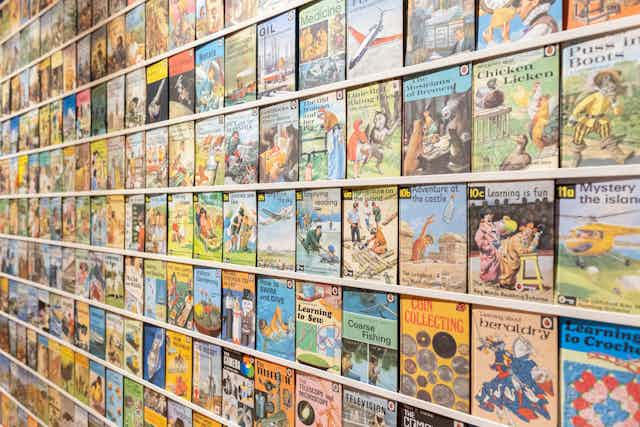The Ladybird books, first published in 1914, helped millions of children learn and love to read over the decades. These hardback, pocket-size books, with bright and interesting artwork on the front, are pretty distinctive. You might have had one in your childhood, or seen one of the many spoofs put out by the original Ladybird publishers in recent years.
They were among the first books made solely with the child reader in mind and featured vivid, detailed and true-to-life illustrations and text simply and articulately expressed by experts in their field. The design of the original books has become iconic, with their full-colour illustrative style and simple typography.
The artwork is central to the success of the books, and to the enduring love many have for them. A quirky and original exhibition at Victoria Art Galley in Bath is celebrating the artists that are responsible for Ladybird’s distinctive look. It has been curated by collector and researcher Helen Day, who became fascinated by the books after seeing her baby so engaged with the artwork on the pages of these old stories.
“I began as a collector but my interest soon broadened into a desire to understand better the social history that the books contain,” Day says in an introduction to the exhibition. She created a website and heard from a variety of people who were eager to share their own Ladybird experiences and stories.
The exhibition features a compelling assembly of books, artefacts, proofs, letters and original artwork by some of the most highly regarded Ladybird artists of the mid-1900s – such as John Berry, Martin Aitchison, Frank Hampson, Charles Tunnicliffe and Harry Wingfield. Many of them exhibited at London’s prestigious Royal Academy and exquisite originals of some of their work hangs on the walls here.
The intriguing biographies and often humorous quotes and anecdotes from these artists tell the story of the growth of a Loughborough printing company into the iconic imprint of children’s publishing. Such was its success, by the mid-1970s Ladybird was selling millions of copies of its Key Words Reading Scheme books. The series featured the characters Peter and Jane. They were known as the kids next door – which they quite literally were, as they were based on the neighbours of illustrator Harry Wingfield.
A host of inspiration
In an interview with TV presenter Richard Wyatt, Day noted that: “in the wartime, paper rationing meant that normal work dried up, but they discovered if they took the largest sheet of paper available at the time, and folded it … in a particular way … you could make an entire mini Ladybird book from just one sheet of paper. That was the winning formula. Suddenly, the brand, the format and some amazing individuals was the sort of chemical combination that sparked off this huge success.”

One of those amazing individuals was editorial director Douglas Keen, who commissioned the artists for the books he conceptualised right up until Ladybird was sold to Pearson, owner of Penguin Books, in 1973. Day notes in the exhibition introduction that Keen had enviable instincts for pairing the right illustrator with the right project.
The most fascinating part of the exhibition is the collection of photographs of the locations, families, friends and neighbours who inspired the illustrators. The roughs of the final illustrations are pinned next to the original artworks, which sit alongside the pages of the books in which they were printed. Eric Winter, who illustrated many of the Well-Loved Tales books, sometimes used his wife as a model. Seeing a photograph of her alongside Winter’s final painting of Cinderella is a delight.
There are 500 books on the walls and 200 available to read. There is even a life-sized model of Tootles the Taxi from one of Ladybird’s most popular books, Tootles the Taxi and Other Rhymes, in which to read them. Younger visitors will love the interactive activities – dressing up in clothing featured in Ladybird books, drawing book covers to display on the noticeboard and completing a discovery trail around the gallery.
Seeing the early decades of Ladybird’s history is a reminder not only of how important it is to publish inspiring content, but also that children’s books should reflect the diverse world we live in. With a 100 years in children’s publishing behind it, it is still growing in important ways.
Ladybird is still publishing books and still helping children learn and love to read. Today’s Ladybird artists come from all over the world, reflecting a variety of cultures, ethnicities and differences. New generations of children can see themselves in the pages of books that they, too, will love and reread.

Looking for something good? Cut through the noise with a carefully curated selection of the latest releases, live events and exhibitions, straight to your inbox every fortnight, on Fridays. Sign up here.

